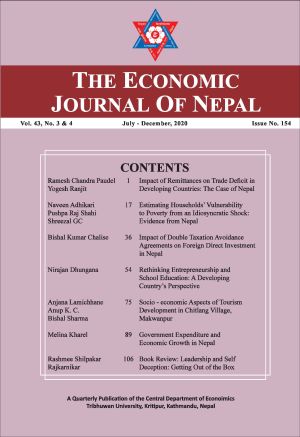Estimating Households’ Vulnerability to Poverty from an Idiosyncratic Shock: Evidence from Nepal
DOI:
https://doi.org/10.3126/ejon.v43i3-4.48035Keywords:
Consumption, Poverty, Vulnerability, Idiosyncratic shocks, NepalAbstract
This paper estimates the vulnerability to the poverty level of the households in Nepal for an idiosyncratic shock using the third round of Nepal Living Standard Survey data. A feasible generalized least square technique is employed to calculate the vulnerability score, further disaggregated between rural-urban areas, provinces, and major caste/ethnic groups. The findings reveal that thirty-two percent of households are highly vulnerable, indicating that they have higher chances of falling below the poverty line due to death, illness, unemployment, and other household-specific shocks. The paper also finds that Karnali and Sudur Paschim Provinces have higher vulnerability than other provinces. Likewise, Dalits and Muslims have higher vulnerability scores compared to other castes / ethnic groups. The estimation suggests that the poverty incidence and vulnerability scores largely overlap, yet the vulnerability scores are consistently higher among all groups indicating a high risk of households falling into poverty. Therefore, it is desirable that major groups’ vulnerability profile, in addition to poverty profile, should be constructed and aligns the pro-poor policies to the vulnerable groups to mitigate the risks of pushing such vulnerable households below the poverty line.
Downloads
Downloads
Published
How to Cite
Issue
Section
License
© Cedecon-TU




